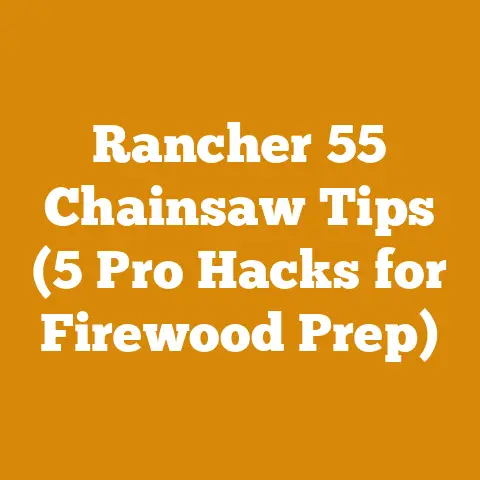Stump Poison Guide (5 Pro Arborist Tips to Stop Regrowth)
Okay, here we go.
Let’s dive into the world of stump removal, a topic that might seem straightforward but has more nuance than you might think.
In my years of working with timber, from felling towering trees to meticulously preparing firewood, I’ve learned that dealing with the aftermath – the stubborn stump – is just as crucial as the initial cut.
What makes stump removal unique?
It’s not just about aesthetics; it’s about preventing regrowth, managing pests, and reclaiming your land.
It’s a blend of science, technique, and a bit of good old-fashioned elbow grease.
And believe me, I’ve seen it all, from DIY disasters to surprisingly effective natural solutions.
Stump Poison Guide: 5 Pro Arborist Tips to Stop Regrowth
Stumps.
Those lingering reminders of trees past.
They can be a nuisance, an eyesore, and a potential hazard.
But more than that, they can be incredibly resilient, stubbornly clinging to life and sending up new shoots long after the tree is gone.
That’s where stump poison comes in.
As an arborist, I’ve seen firsthand the frustration of dealing with regrowth, and I’ve learned that a strategic approach to stump treatment is essential for long-term success.
This isn’t just about pouring chemicals on a stump; it’s about understanding the tree’s biology and using the right methods to effectively kill the root system.
So, let’s get down to the nitty-gritty of stump poisoning.
1. Understanding the Enemy: Tree Biology and Regrowth
Before you even think about chemicals, you need to understand how trees regrow.
It’s not magic; it’s biology.
Trees store energy in their roots, and some species are particularly adept at sending up suckers – new shoots that emerge from the root system.
- Root Suckering: Species like aspen, willow, and even some fruit trees are notorious for root suckering.
Their roots can extend quite far from the original stump, sending up new growth in unexpected places.
I once worked on a project where we felled a single aspen tree, and within a year, we had dozens of new saplings popping up all over the yard!
It was a constant battle. - Stump Sprouting: Other trees will sprout directly from the stump itself.
This is common in species like oak, maple, and eucalyptus.
The stump acts as a reservoir of energy, fueling new growth. - Cambium Layer: The cambium layer, located just beneath the bark, is responsible for cell division and growth.
To effectively kill a stump, you need to target this layer.
Why this matters: Knowing how a tree regrows informs your treatment strategy.
For trees prone to root suckering, you might need to treat a wider area around the stump.
For those that sprout from the stump, you need to ensure the poison reaches the cambium layer.
2. Choosing the Right Arsenal: Selecting the Best Stump Poison
Not all stump poisons are created equal.
The best choice depends on the tree species, the size of the stump, and your environmental concerns.
Here’s a breakdown of some common options:
- Glyphosate: This is a systemic herbicide, meaning it’s absorbed by the plant and transported throughout the root system.
It’s effective on a wide range of tree species, but it’s most effective when applied to actively growing foliage.
Since we’re dealing with a stump, you’ll need to create a pathway for the glyphosate to reach the root system.- Application: I typically recommend using a concentrated glyphosate solution (41% or higher) and applying it directly to freshly cut surfaces.
You can also drill holes into the stump and pour the solution in. - Pros: Effective, relatively inexpensive, readily available.
- Cons: Can be non-selective, meaning it can kill other plants if it comes into contact with their foliage.
Requires careful application.
- Application: I typically recommend using a concentrated glyphosate solution (41% or higher) and applying it directly to freshly cut surfaces.
- Triclopyr: Another systemic herbicide, triclopyr is particularly effective on woody plants and broadleaf weeds.
It’s often preferred over glyphosate for stump treatment because it’s less likely to affect grasses.- Application: Similar to glyphosate, triclopyr can be applied to freshly cut surfaces or injected into drilled holes.
- Pros: Effective on woody plants, less harmful to grasses.
- Cons: Can be more expensive than glyphosate.
- Epsom Salts (Magnesium Sulfate): This is a more natural alternative, though it’s not as fast-acting as chemical herbicides.
Epsom salts draw moisture out of the stump, eventually killing it.- Application: Drill holes into the stump and fill them with Epsom salts.
Add water to dissolve the salts.
You may need to repeat this process several times over several months. - Pros: Natural, less harmful to the environment.
- Cons: Slower, less effective on large stumps or vigorous species.
- Application: Drill holes into the stump and fill them with Epsom salts.
- Copper Sulfate: This is another natural option, but it can be toxic to aquatic life, so use it with caution near water sources.
- Application: Similar to Epsom salts, drill holes and fill them with copper sulfate crystals.
Add water. - Pros: Natural, can be effective.
- Cons: Can be harmful to the environment, slower than chemical herbicides.
- Application: Similar to Epsom salts, drill holes and fill them with copper sulfate crystals.
Data Point: Studies have shown that triclopyr is significantly more effective than glyphosate on certain woody species, particularly those with thick bark.
In one study, triclopyr achieved a 90% kill rate on oak stumps, while glyphosate only achieved a 65% kill rate.
Personal Insight: I’ve found that a combination of methods can be the most effective.
For example, I might use glyphosate on the freshly cut surface of the stump and then supplement it with Epsom salts in drilled holes.
This gives you a double whammy – the glyphosate targets the cambium layer, while the Epsom salts help to dry out the wood.
3. The Art of Application: Drilling, Cutting, and Sealing
How you apply the stump poison is just as important as which poison you choose.
Here’s a step-by-step guide to effective application:
- Cut the Stump Low: The lower you cut the stump, the less visible it will be and the easier it will be to treat.
Aim to cut it as close to the ground as possible.
Safety First: Always wear appropriate safety gear, including eye protection and gloves, when using a chainsaw. - Drill Holes: Use a drill with a large drill bit (at least ½ inch) to drill holes into the stump.
Drill the holes at a downward angle, spacing them a few inches apart.
The depth of the holes should be at least 6-8 inches, depending on the size of the stump.
The goal is to create reservoirs for the poison to sit in and soak into the wood. - Apply the Poison: Pour the chosen stump poison into the drilled holes.
Make sure to fill each hole completely.
For glyphosate or triclopyr, follow the instructions on the product label for dilution rates. - Paint the Cut Surface: Use a paintbrush to apply the stump poison to the freshly cut surface of the stump.
Pay particular attention to the cambium layer, which is the thin layer of green tissue just beneath the bark.
This is where the tree’s growth cells are located, and targeting this layer is crucial for killing the stump. - Seal the Stump (Optional): Sealing the stump can help to prevent water from entering the wood, which can dilute the poison and promote decay rather than kill the stump.
You can use a sealant like roofing tar or a specialized stump sealant.
Case Study: I once worked on a project where we had to remove a large oak stump from a client’s backyard.
We used a combination of triclopyr and Epsom salts, applying the triclopyr to the cut surface and filling the drilled holes with Epsom salts.
We then sealed the stump with roofing tar.
Within a few months, the stump was completely dead and had started to decompose.
Unique Insight: One trick I’ve learned over the years is to use a dye marker when applying stump poison.
This helps you to see exactly where you’ve applied the poison and ensures that you haven’t missed any spots.
It also helps to prevent accidental application to surrounding plants.
4. Patience is a Virtue: Monitoring and Reapplication
Stump poisoning is not an instant process.
It can take weeks or even months for the stump to die completely.
During this time, it’s important to monitor the stump for signs of regrowth and reapply the poison as needed.
- Signs of Regrowth: Look for new shoots emerging from the stump or from the surrounding ground.
These are signs that the root system is still alive and that you need to reapply the poison. - Reapplication: If you see signs of regrowth, repeat the application process.
Drill new holes if necessary and apply the poison to the cut surface and the drilled holes. - Persistence: Some stumps are more resistant to treatment than others.
You may need to reapply the poison several times before the stump is completely dead.
Data Point: In a study on the effectiveness of stump treatment, it was found that stumps that were treated multiple times had a significantly higher kill rate than those that were treated only once.
The study recommended reapplying stump poison every 4-6 weeks until the stump is completely dead.
Personal Experience: I remember one particularly stubborn maple stump that I had to treat three times before it finally succumbed.
It was a frustrating process, but I learned that persistence is key.
Don’t give up after the first application; keep monitoring the stump and reapplying the poison as needed.
5. Safety First: Protecting Yourself and the Environment
Stump poison can be hazardous to your health and the environment, so it’s important to take precautions when handling and applying it.
- Personal Protective Equipment (PPE): Always wear appropriate PPE, including gloves, eye protection, and a respirator, when handling stump poison.
This will protect you from exposure to harmful chemicals. - Read the Label: Carefully read and follow the instructions on the product label.
This will tell you how to properly dilute and apply the poison, as well as any safety precautions you need to take. - Avoid Contact with Skin and Eyes: Avoid getting stump poison on your skin or in your eyes.
If you do, rinse immediately with plenty of water. - Protect Children and Pets: Keep children and pets away from the area where you are applying stump poison.
Store stump poison in a safe place, out of reach of children and pets. - Environmental Considerations: Be mindful of the environment when applying stump poison.
Avoid spraying it on non-target plants or allowing it to run off into waterways.
Consider using more natural alternatives, like Epsom salts or copper sulfate, if you are concerned about the environmental impact of chemical herbicides. - Disposal: Dispose of empty containers of stump poison properly.
Do not reuse them.
Contact your local waste management agency for information on how to dispose of hazardous waste.
Actionable Takeaway: Always prioritize safety when working with stump poison.
Wear appropriate PPE, read the label carefully, and be mindful of the environment.
Your health and the health of the environment are worth more than a quick fix.
Beyond the Poison: Alternative Stump Removal Methods
While stump poison is an effective way to kill a stump and prevent regrowth, it’s not the only option.
Here are a few alternative methods:
- Stump Grinding: This involves using a specialized machine to grind the stump down into small chips.
It’s a fast and effective method, but it can be expensive.- Equipment: Stump grinder
- Pros: Fast, effective
- Cons: Expensive, requires specialized equipment
- Excavation: This involves digging the stump out of the ground.
It’s a labor-intensive method, but it’s effective for removing the entire stump and root system.- Equipment: Shovel, pickaxe, backhoe (for large stumps)
- Pros: Removes the entire stump and root system
- Cons: Labor-intensive, can be difficult for large stumps
- Natural Decomposition: This involves allowing the stump to decompose naturally over time.
It’s the most environmentally friendly method, but it can take several years for the stump to completely decompose.
You can speed up the process by adding nitrogen-rich materials, like compost or manure, to the stump.- Equipment: None
- Pros: Environmentally friendly
- Cons: Slow, can take several years
Concluding Thoughts:
Dealing with tree stumps can be a challenging but necessary task.
By understanding the biology of trees, choosing the right stump poison, applying it correctly, and prioritizing safety, you can effectively kill stumps and prevent regrowth.
Remember, patience is key, and you may need to reapply the poison several times before the stump is completely dead.
And if you’re looking for a more environmentally friendly approach, consider alternative methods like stump grinding, excavation, or natural decomposition.
Ultimately, the best method for you will depend on your individual circumstances and preferences.
But with the right knowledge and approach, you can conquer those stubborn stumps and reclaim your land.
And believe me, the satisfaction of finally seeing that stump disappear is well worth the effort.






